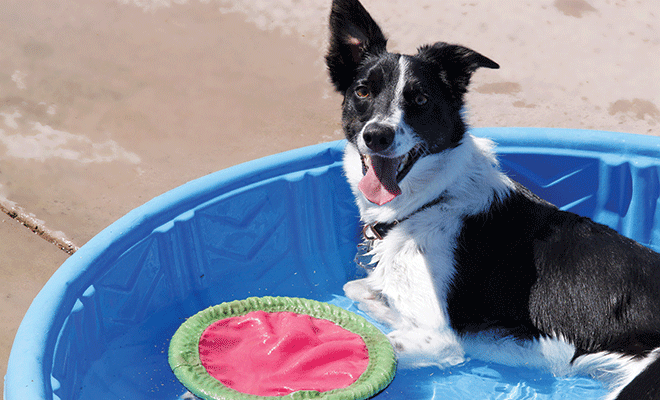
Keeping pets safe as summer heats up
When we think of the summer months, our thoughts are often directed toward lazy days lounging by the pool, cool drink in one hand, gossip magazine or romance novel in the other, and the warm sun bathing us in happiness.
If we’re not careful, however, long days outside in the sun and heat can result in health hazards. Staying hydrated, wearing sunblock and donning a wide-brimmed hat and sunglasses can minimize adverse effects from the heat.
When it comes to our pets, it’s equally important to understand how to make sure they stay safe and enjoy the summer sun. Veterinarians and websites offer many helpful tips that you can employ to make sure your pet remains healthy while still taking advantage of the many perks of summer.
Probably one of the biggest issues–and obvious no-no’s–centers around pets and cars. Leaving a pet in a parked car can be a death sentence. Even on an 85-degree day with the windows slightly open, the temperature inside the car can escalate to 120 degrees in the blink of an eye. Being left in these conditions for even a minute can subject your pet to irreversible organ damage or death.
You’ve heard the familiar saying, “It’s not just the heat; it’s the humidity.” Never did a truth ring more clearly. When overheated, pets will pant to evaporate moisture from their lungs, which takes the heat away from their body. However, if the humidity is too high, they risk being unable to effectively cool themselves, which can quickly send their body temperature through the roof. If you and your dog enjoy daily walks or certain times for play and exercise, avoid the heat of the day and adjust your schedule to do this in the early morning or evening hours, when the dangerous wrath of the sun is not directly overhead. Remember, too, that asphalt can seriously burn your pet’s paws, so keep him on the grass as much as possible. Make sure your pet has access to plenty of cool water, too.
Don’t forget the sunscreen! Skin cancer is one of the most common forms of cancer in dogs and is second most common in cats. Fur may offer some protection from the sun, put it is important to apply a pet sunblock every three to four hours on areas that have less hair, including bellies on dogs and ears and around the eyes on cats.
You may scratch your head at this idea, but resist the urge to trim your dog’s coat. Even though it would be silly for us to walk around in 90-degree heat wearing a parka, your pet’s fur, even when long, actually stimulates circulation while simultaneously regulating body temperature, as long as it is brushed and free from matting. While it may seem like common sense to help your pet cool down with the aid of a fan, pets will not realize the same relief as you do, as they sweat through their feet and cannot cool off as effectively as you can with a fan.
Whenever your pet is outside, be sure to give him access to plenty of shade and fresh, cool water. When the temperature soars to heat wave proportions, consider adding some ice cubes to his water dish. Because a dog house actually traps heat inside, tree shade or tarps are far more effective in providing relief because the air flow is unobstructed.
The heat can be insidious and can sneak up on you if you’re not fully prepared, which means it is important to understand and know the warning signs of heatstroke in pets. Indicators of stress in your pet due to heat stroke may include heavy panting, a rapid heartbeat, breathing troubles, extreme thirst, lethargy, vomiting, glazed eyes, excessive salivation, seizure or, in some cases, unconsciousness. Your pet is far more likely to sustain health issues from the heat if he is older or very young, overweight, not properly conditioned for exercise, or suffers from certain heart and respiratory diseases. Cats with short muzzles and certain breeds of dogs, such as pugs, boxers and shih tzus, typically have a much harder time breathing in the heat.
If you suspect your pet is suffering from heat stroke, make sure to immediately move him to an air-conditioned area or into the shade. To facilitate lowering the body temperature, apply ice packs or cold towels to his head, neck and chest or simply run cool water over him. Offer small amounts of water or let him lick an ice cube. Then make sure to immediately seek veterinary care.
Above all, if it’s too hot for you, then it’s too hot for your dog. Common sense goes a long way to keep your pets safe, healthy and happy this summer! HLM
Sources: humanesociety.org and prevention.com.







